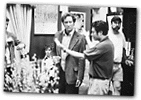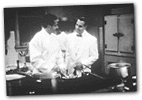DISTANT VOICES
Ellen Wolff on the Latest in Location Sound Recordings
Once upon a time, location sound recording was a simple process. You bought a Nagra, slung it over your shoulder, and went to work. But in the last few years, many new location recording choices have arisen. Digital audio tape (DAT) machines from several manufacturers have become increasingly affordable, portable, and - given their computerized technology - upgradable. Since DATs rising popularity continues to erode the supremacy of Nagra's analog recorders, it's clear that the business of location sound is changing. And those who work in this area have some definite opinions about the state of things today and where the field might be headed.
 |
| On the set of Ang Lee's Ice Storm Photo: Adger W. Cowans |
When it comes to convenience, however, Pullman observes that with DAT "you've got two hours of recording time - you actually wind up changing batteries more than cassettes." But he cautions that the software-driven nature of DAT machines makes them subject to glitches. "There are technical drawbacks which are irreparable in the field. It's like a video machine, where if you have high humidity you can run into problems. And in terms of its overload capabilities, DAT is less forgiving."
Sound recordist Tom Paul agrees that "it's easy to screw up digital sound when you're mixing it and processing it." Paul, whose credits include Little Odessa and Eat, Drink, Man, Woman, also handled the sound for "the first independent low-budget feature I'd ever heard of being recorded on DAT" - Ang Lee's 1992 The Wedding Banquet. An eight-year veteran who does both location and postproduction sound, Paul believes the profession is in a transitional time and that the limitations of current DAT technology make some skepticism understandable. He admits that he prefers "the sound of analog over 16-bit digital, which is the current limitation of location DAT [recorders.] When it goes to 20-bit digital, things are going to get a lot better. Sixteen-bit DAT is o.k. for dialog - digital gives you basically what you put in."
But Paul believes that "Nagra continues to be loved over DAT, because the analog recording process actually does something to the sound. It sort of compresses it a little bit and smoothes out the harshness of some of the high frequencies." He points out that while the standard sampling rate "of 48,000 samples per second is very, very dense in terms of resolution, it still is audio broken down into 48,000 tiny pieces streaming back at you, whereas analog is continuous. Analog colors sound in a way that's very pleasing for dialog. I think it sounds wonderful. However, having said that, I don't generally use it these days, mainly for reasons of compatibility."
A user of Fostex's PD-2 time code DAT machine, Paul feels that putting digital recording in its proper context means thinking about sound as data. "The DAT recorder is nothing more than a tape drive storing data. It's an analog-to-digital converter with a tape drive attached." He observes that "tape is a really efficient, cost-effective way of going into the field and getting a whole bunch of data recorded, because you can just coil it up and put it in a little cassette. But the data doesn't have any clue whether it's going on a magneto-optical disk or a removable hard drive, or if it's going into RAM or getting directly transmitted through a T-1 phone line to a post house. It doesn't make a difference. It's just 0s and 1s."
 |
| Stanley Tucci and Cambell Scott's Big Night Photo: John Clifford |
The demands of digital post are actually spurring today's trends, believes sound recordist Larry Loewinger, whose credits include From Mao to Mozart and The Last Romantic. "Ever since time code came on board for film recording, what we do in the field has largely been dictated by the needs of postproduction, and AVID editors prefer to see a time code DAT tape."
Economics are also spurring the acceptance of time code DAT recorders. Loewinger, who operates the N.Y. rental business Soho Audio, notes that three portable time code DATs - the Fostex PD-2 and PD-4 and the HHB Time Code Portadat - "are cheaper, for the most part, than the time code Nagras. It's because a DAT recorder is basically a miniature VCR." Although serviceable DAT machines in the $5 - 6,000 price range are very attractive when compared to a $12,000 Nagra, Loewinger notes that current DAT technology is not without its downside. "Because the format is so miniaturized, any imperfection in the tape can become a very large problem. Everything has to be very precisely aligned in the DAT world."
Thus far, Nagra hasn't attempted to compete in the DAT cassette market. Their Nagra-D, a 20- bit digital, reel-to-reel 4-track, is considered by many to be too cumbersome for location recording. Ron Topham of Audio Services, a New York-based sales and rental house, calls the Nagra-D "a bit of overkill for the market." Not only does it cost around $25,000, but, notes Topham, "It also uses a proprietary format tape which you have to buy from Nagra. What's needed is small, a four or five pound machine that sells for under $5,000 and records two-track digitally. They didn't meet that market."
Jim Guzzi of New York's Professional Sound Services agrees that the Nagra-D's price "is astronomical, especially considering that you can get the Stelladat, the king of DAT machines, for around $15-16,000." Guzzi questions the practicality of using multi-track machines on location at all. "Those machines are a lot larger. Although it wouldn't be a problem putting a Tascam DA-88 on a sound cart, it would take up some room. On Die Hard With A Vengeance they used the Fostex RD-8, a multi-track digital recorder, but I haven't found a lot of guys asking for that."
Billy Sirokin, for one, says, "I'm hoping that Tascam comes out with a smaller, field-friendly eight-track machine, because they're a huge player in post production. The first generation of multi-track machines are too bulky, and they don't like to be bounced around on a sound cart." Sirokin sees a use for multi-track on some locations, noting that "on Big Night, almost half the film was a huge party scene with 25 speaking characters. There was two camera coverage and of lots of simultaneous action, so I used the Fostex eight-track ADAT. I had eight channels recording independently."
Larry Loewinger notes that while "multi-track machines from Tascam, Alesis and Fostex are used in the field, they require a fair amount of support gear, and usually one extra person at least. You're tending not to see them on small projects, but on projects that can afford to have three to five people in the sound department."
Considering the trend towards multi-track recording on multi-camera shoots, Loewinger observes that "in the last five years, there's an increasing need to provide monitor feeds to different people on the set. People want to hear exactly what they think they're going to get." Paul also thinks the impetus towards multi-track location recording is growing, perhaps aided by the fact that "a multi-track digital recorder is cheaper than a time code DAT. A Tascam DA-88 with full blown time code costs about $4,500. My Fostex PD-2 time code DAT cost $13,000."
But Paul sees repercussions of multi-track location recording. "There's a ripple effect for dailies. Dialog editors, instead of cutting two tracks, have five or eight tracks, which puts mixing decisions into a non-real time environment... at $400-600 dollars an hour. You don't have the dynamic of the real time, adrenaline-filled mixing experience."
In today's production climate, where having discrete elements for digital post manipulation is prized, it's not surprising that dialog tracks are frequently isolated using wireless microphones. This is one area of location sound work where the pros are in agreement - they all believe wireless diversity microphones are fantastic. Diversity mikes, where two or more antennae are used to pick up transmitter signals, "have revolutionized radio mikes," says Billy Sirokin. The Audio Ltd. mikes which Sirokin uses "work within hundreds of feet, and in New York, where you're battling so much radio interference, it's wonderful to get any radio mike to work within more than 20 feet."
Loewinger agrees that "having diversity mikes is the big change. It's very hard to walk onto a serious feature set without a package of UHF diversity microphones. The director simply will expect you to pick up dialog from an actor 100 to 200 feet away. Probably the best diversity package is made by Audio Ltd. in England. But they're very expensive, they consume a lot of power and require a certain amount of maintenance, too."
Bill Sien of Systems Wireless in Herndon, Virginia thinks the challenge for sound recordists is dealing with RF interference. "If you're doing multiple camera shoots where you have several people working with wireless, each one of those systems can cause interference. Because of this, manufacturers are moving into the UHF band where there are considerably more frequencies."
Sien recommends Lectrosonics, "which is coming out with a studio system where the receiver itself serves as a spectrum analyzer. It will find out where the interfering signals are so that you can avoid those frequencies, and allow you to set your system so you don't have interference. It will take some time before that gets to the portable market, but with everything becoming smaller, eventually they'll have that capability."
Scott Schachter of the New York sales and rental house Scharff Weisberg thinks the trend is toward "fully synthesized, computer-controlled wireless microphones. Vega has new low cost, UHF wireless mikes, and Sennheiser and Shure have new UHF systems in the $1,000-2,000 price range. But when you're only using it for a short time, just rent it. If you go out and spend $2,000 on a wireless, tomorrow there could be a newer one that's less money."
This is a possibility that confronts sound recordists in virtually every aspect of their business today. Loewinger believes that eventually "we're going to move to some kind of computerized recording. When people come up with a hard disk system that works well in the field, DAT will go away." Topham notes that Nagra is working on "a solid state recorder that has no moving parts and records on computer cards. The future of recording for the motion picture and video industries is going to be solid state, computer-type recording. It's down the road a few years, but it's the wave of the future."
Sirokin speaks for many pros when he says, "Nobody really knows what the next format will be - a hard drive or a credit card memory chip? Obviously it will be digital, but nobody knows what the actual recording medium will be." Jeff Pullman, however, has one item for his futuristic wish list: "Liquid mikes - you just swallow 'em, they last 10 minutes, and you're done!"
VOD CALENDAR


 See the VOD Calendar →
See the VOD Calendar →


